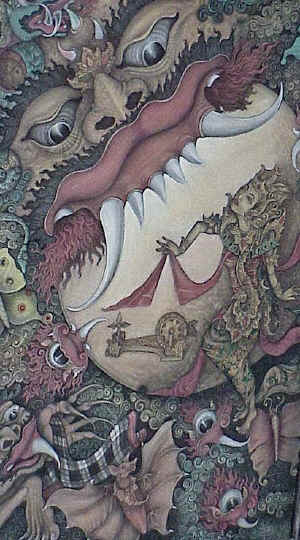|
| |
[ Up ]
[ Cast System ] [ Cremation ] [ Music and Dance ] [ Religion ] [ Rites of Passage ] [ Special Days ] [ The Home ] [ Way of Life ]
Cremation
 |
Cremation of the dead (pengabenan pelebon), the ceremony pitra yadna
is perhaps the most important and often the most colorful, ritual in Balinese
religion. A cremation is necessary
for the soul of the deceased for the passage into heaven and reincarnation and
is liberation from material attachments. Due to the immense,
cost and the complicated preparations necessary, cremations often occur long
after the death of the person. Usually,
group cremations are held in order to share the expense and the labor involved.
Between death and cremation the body is buried in the cemetery, or in the
case of a wealthy person whose family can arrange a cremation more quickly, the
body lies in state in the family compound.
During this time the soul of the deceased is thought to be agitated,
longing for release.
An auspicious day for the cremation is chosen by a Pedanda, or priest, after
consulting the Balinese calendar. Preparations begin long before the appointed
day, each family builds a large tower of bamboo and paper, extravagantly painted
according to the caste and wealth of the deceased, on a large bamboo platform.
A magnificent, brightly colored, life size bull, winged lion, or elephant
creature is also constructed of Kapok wood, bamboo and cloth or colored papers
that is used to hold the body for cremation.
On the morning of the cremation relatives and friends of the deceased visit
the house to pay their last respects, and are richly entertained and fed by the family.
At midday the body is taken from the house, placed in the tower and
carried with the bull, to the dead manís Cemetery. This
becomes a loud noisy, boisterous procession, designed to confuse the soul of the
deceased so that it will loose its way and not be able to return to the family
compound, where it could cause mischief.
|
At
the cremation ground the body is put into the belly of the creature. A priest
officiates at the last rites, and then the fires are lit.
After burning the ashes are gathered and taken to the sea or the local
river where they are thrown to the wind. This
represents the cleansing and disposal of the material body, and is cause for
singing and laughter in the care of the soul in the family compound.
After a sojourn in heaven the soul is believed to be reborn.
The status of the reborn soul relates to the personís karma, or his
conduct in previous lives. In
general the Balinese feel that the soul is reborn within the same circle of
death and rebirth, this explains the Balinese reference for their ancestors.
Every Balinese knows that the other world must be respected and cared for
if he is return to his beloved island of Bali.
The village of Trunyan on Danau Batur (lake Batur) is the only village on
Bali where bodies are not cremated, instead they are buried in a cemetery.
[ Back ] [ Next ]
[ Cast System ] [ Cremation ] [ Music and Dance ] [ Religion ] [ Rites of Passage ] [ Special Days ] [ The Home ] [ Way of Life ]
|
